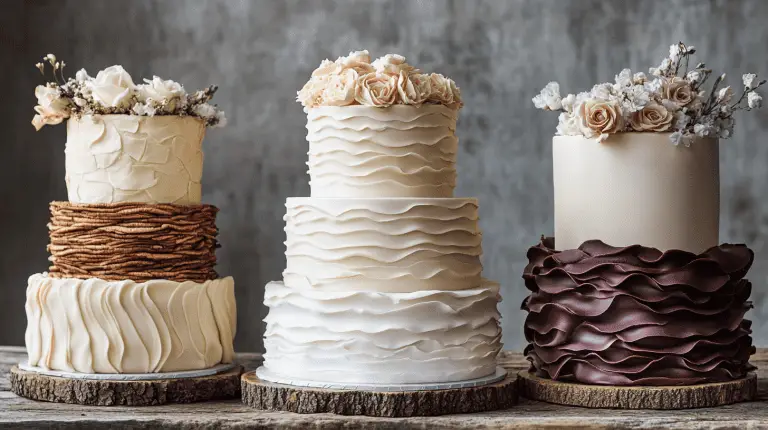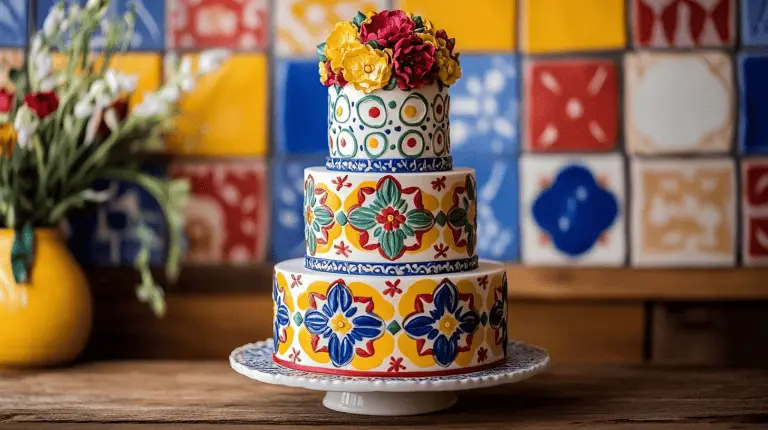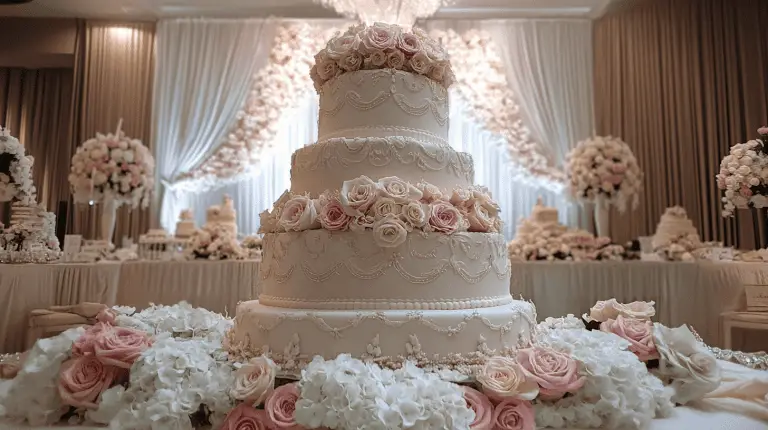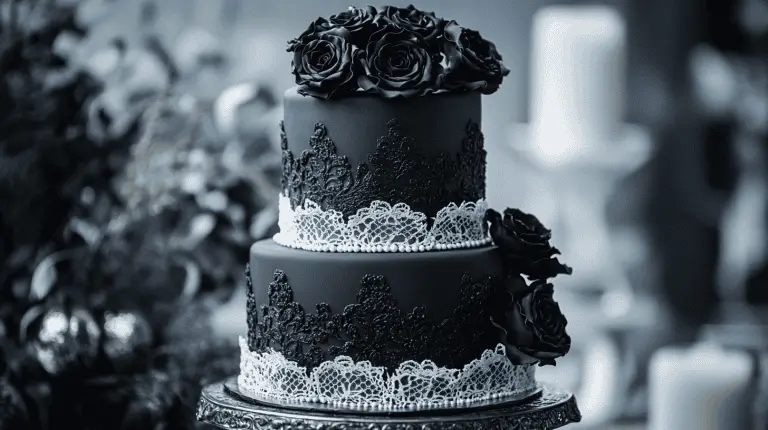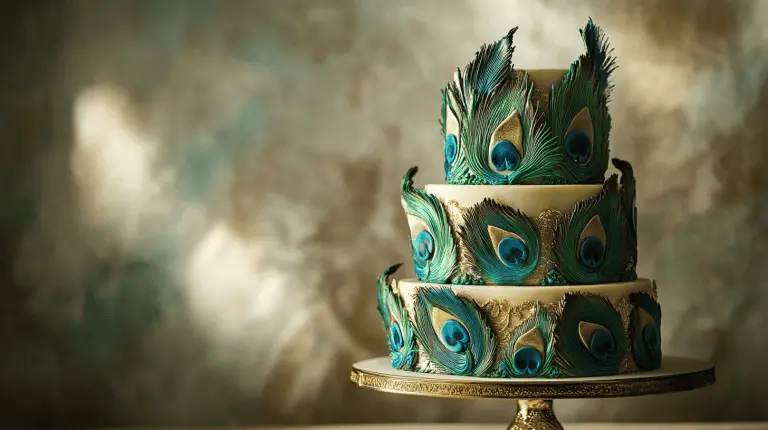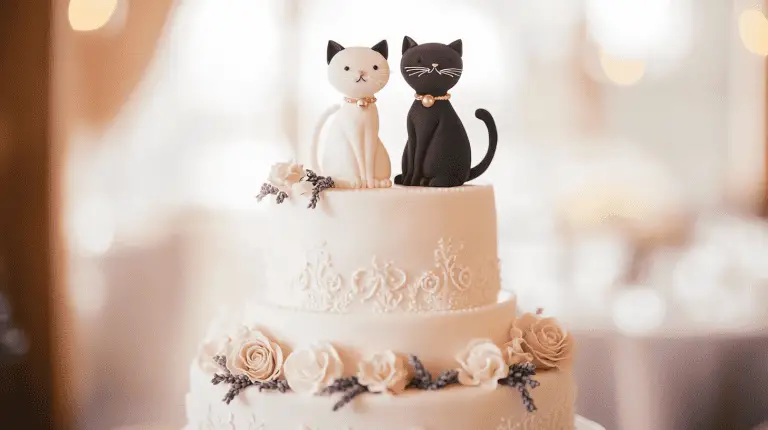Wedding Cake Servings Calculator: Guide to Sizing and Planning
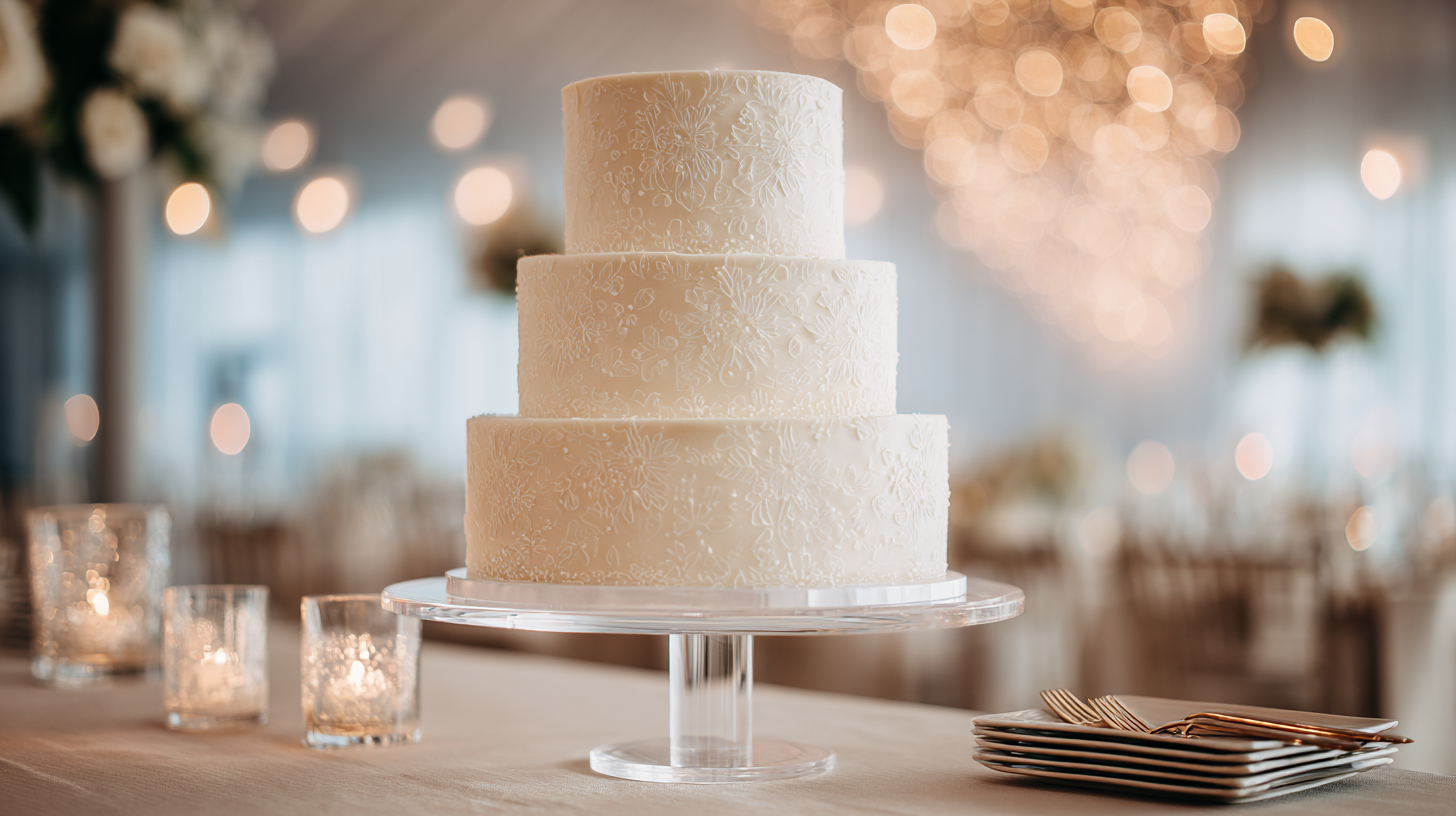
Wedding Cake Servings Calculator: Guide to Sizing and Planning
Planning the perfect wedding cake can feel overwhelming, especially when you’re trying to figure out how many servings you’ll need for your guest list. A wedding cake servings calculator lets couples figure out the right size and number of cake tiers based on their guest count, making sure everyone gets dessert without ending up with a mountain of leftovers or an empty cake stand. These tools really take the guesswork out of cake planning by giving you measurements and tier suggestions that actually make sense.
Most couples don’t realize how complicated wedding cake planning can get. You have to think about standard serving sizes, cake shapes, and even the style of cake you want. A good calculator looks at more than just numbers—it’ll factor in whether you’re going with a classic tiered cake or sheet cakes, what your guests might prefer, and if you’ll have other desserts at the party.
🎂 What Size Wedding Cake Do I Need?
How to Use a Wedding Cake Servings Calculator
You’ll need to plug in some specific info to get a reliable answer from a wedding cake servings calculator. The right guest count and an idea of how big you want your slices will make all the difference.
Steps for Calculating Wedding Cake Servings
First, pop your total number of wedding guests into the calculator. Only count people who’ve confirmed they’re coming—no need to include everyone you invited if they’re not actually showing up.
After that, pick your preferred serving size. Wedding cake slices usually go from dainty 1×2 inch pieces to chunkier 2×4 inch ones, but most calculators stick with a 2×2 inch slice as the standard.
The calculator spits out how many tiers you’ll need. It’ll even give you suggested diameters for each tier, like 6-inch, 9-inch, and 12-inch rounds, depending on your guest count.
If you care about how the cake looks, you can tweak the number of tiers. Some folks want a tall, dramatic cake with more tiers, while others are fine with fewer, bigger layers.
Finally, you’ll see the total servings each tier gives you. This is super helpful for bakers—they can plan ingredients and make sure there’s enough cake for everyone.
Input Information Needed
These calculators mainly need your guest count. Make sure you include everyone who’ll get cake, not just those sitting down for dinner.
You’ll usually get asked how many tiers you want. You can pick 2, 3, 4, or more, depending on what you’re picturing for your big day.
Here’s what you’ll typically need to input:
- Total number of guests
- Preferred serving size
- Number of desired tiers
- Cake shape (round or square)
- Tier heights (usually 3-8 inches)
Some calculators go the extra mile and ask about frosting type or dietary restrictions. Those details can definitely change how much cake you’ll need.
Common Mistakes to Avoid
People often forget to count kids or folks just coming to the evening reception. If they’re getting cake, they need to be included in your total.
If you pick a serving size that’s too tiny, you’ll end up with cranky guests who want more cake. Don’t skimp—wedding cake slices should feel like a treat after a big meal.
Other common slip-ups:
- Skipping the vendor tastings
- Not saving the top tier for your anniversary
- Forgetting about dietary restrictions
- Picking tier heights that don’t fit your venue
And honestly, don’t just trust the calculator blindly. Chat with your baker about the results. They’ll know if those numbers work with their recipes and what’s doable in their kitchen.
Understanding Cake Serving Sizes and Standards
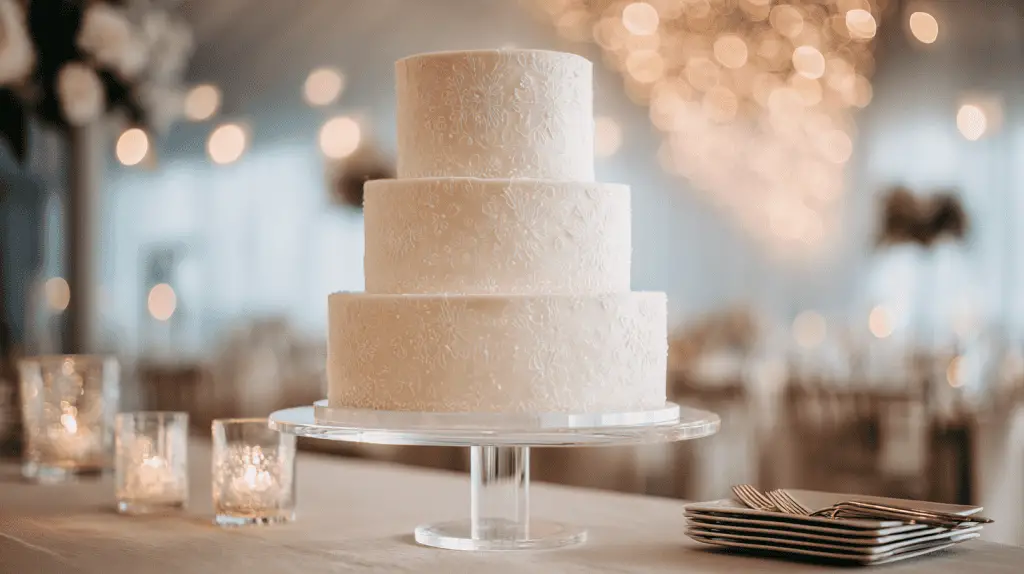
Wedding cakes need a different approach for slicing and serving than your average birthday cake. The standard wedding cake slice is 1 inch by 2 inches, and how tall each layer is can totally change how many pieces you actually get.
Wedding Versus Party Cake Servings
Wedding cakes stick to pretty formal serving sizes. That classic 1 inch wide by 2 inches deep cut makes for a smaller, elegant piece—perfect for a dressed-up dinner.
Party cakes? They’re a bit more relaxed. Slices are usually bigger—maybe 1.5 by 2 inches or even more. At casual get-togethers, people expect a more generous serving.
Most wedding planners figure about 75 to 85 percent of guests will eat cake. Some folks have dietary restrictions, some just aren’t cake people, and others might want seconds or want to try different flavors. It’s a bit of a guessing game, honestly.
Quick comparison:
- Wedding slices: 1″ x 2″ (formal)
- Party slices: 1.5″ x 2″ (casual)
- Wedding: 75-85% of guests eat cake
- Party: 80-90% of guests eat cake
Standard Cake Slice Dimensions
Bakers use pretty specific measurements to keep portions consistent. The go-to wedding cake slice is 1 inch wide, 2 inches deep, and as tall as the cake layer (which is usually 4-6 inches).
Standard measurements:
- Width: 1 inch
- Depth: 2 inches
- Height: Full layer thickness (usually 4-6 inches)
Some bakers offer “generous” slices—think 1.25 by 2.5 inches. That’s great for laid-back parties or when cake is the main dessert.
When figuring out servings, the pros use these numbers. For example, a 10-inch round cake gives you about 38 standard servings if you cut it right.
Importance of Cake Height in Servings
The height of your cake layers changes everything. Taller cakes mean more cake per slice, and you can actually squeeze 20-30 percent more servings out of the same diameter if you go tall.
Most wedding cake layers are 4 inches tall. If you double that to 8 inches, you nearly double your servings. A 10-inch cake at 4 inches tall serves 38 people, but if it’s 8 inches tall, it’ll serve around 60. That’s a big difference.
Height makes a real impact:
- 3-inch layer: About 25% fewer servings
- 4-inch layer: The standard
- 6-inch layer: 50% more servings
- 8-inch layer: Nearly double
Bakers also have to think about how much the cake settles and how thick the frosting is. Dense cakes like fruitcake hold their height better than fluffy sponge cakes, which can squish down a bit.
Types of Wedding Cakes and Their Serving Quantities
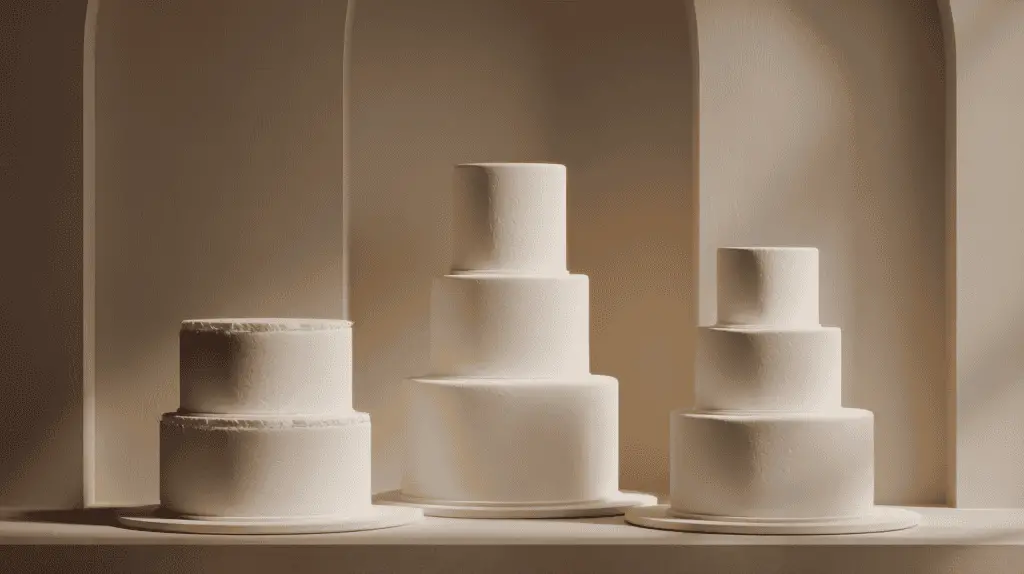
The number of servings you get from a wedding cake depends a lot on its shape, size, and how it’s built. Round cakes usually serve fewer people than square ones of the same size, and tiered cakes let you serve a crowd without needing a massive cake footprint.
Round and Square Cake Servings
Round cakes are definitely the classic pick. A 6-inch round cake serves about 8-10 people, 8-inch gives you 12-16, and 10-inch gets you 20-30 servings.
Square cakes actually give you more slices for the same diameter. A 6-inch square cake serves 12-18, 8-inch gives 18-24, and 10-inch goes up to 32-40 servings. Handy if you’re trying to stretch your cake budget a bit.
Round Cake Servings:
- 6-inch: 8-10 servings
- 8-inch: 12-16 servings
- 10-inch: 20-30 servings
- 12-inch: 40-50 servings
Square Cake Servings:
- 6-inch: 12-18 servings
- 8-inch: 18-24 servings
- 10-inch: 32-40 servings
- 12-inch: 50-60 servings
Tiered Cake Servings by Tier and Size
Tiered cakes mix and match sizes for a wow factor and more servings. For about 50 guests, a two-tier cake does the trick—usually a 10-inch bottom (36 servings) and a 6-inch top (14 servings).
For medium weddings, three tiers are the norm. Think 12-inch (64 servings), 9-inch (28 servings), and 6-inch (14 servings) for around 100 guests.
If you’re throwing a big bash, you’ll need more tiers. A five-tier cake for 200 guests might stack up 14-inch, 12-inch, 10-inch, 8-inch, and 6-inch layers, hitting somewhere close to 850-900 servings. That’s a lot of cake.
Popular Tiered Combos:
- 50 guests: 2 tiers (10″ + 6″)
- 100 guests: 3 tiers (12″ + 9″ + 6″)
- 200 guests: 5 tiers (14″ + 12″ + 10″ + 8″ + 6″)
Choosing Between Layered and Single-Layer Cakes
If you’re having a small wedding—under 30 people—single-layer cakes are a solid choice. A 12-inch single layer serves about 25-30. They’re usually more budget-friendly and way easier to move around.
Layered cakes bring the drama for bigger parties. You can mix flavors, cover dietary needs, and keep that top tier for your first anniversary if you’re sentimental like that.
With multi-layered cakes, you get more height without needing a giant table. A three-layer cake can serve as many people as a massive single-layer cake, but it looks way more impressive.
Think about how your venue handles cake cutting. Huge single-layer cakes need a pro with a big knife, while tiered cakes break down into more manageable pieces for the staff.
Sheet Cakes and Their Role in Weddings
Sheet cakes are a lifesaver when you need to feed a crowd but don’t want to blow your budget. They’re rectangular, easy to cut, and pair perfectly with a smaller, fancier display cake for those all-important photos.
Sheet Cake Sizes and Servings
A full sheet cake is 18″ × 24″ and serves about 96 people with standard wedding slices. Half sheets (18″ × 12″) serve roughly 48, and quarter sheets handle about 24 guests.
Wedding cake slices are usually 1″ wide, 2″ deep, and 4″ high. That keeps things consistent, no matter where you’re celebrating or who’s doing the cutting.
Most wedding sheet cakes come in these sizes:
- Quarter sheet (9″ × 13″): 24 servings
- Half sheet (12″ × 18″): 48 servings
- Full sheet (18″ × 24″): 96 servings
Bakers can scale up or down depending on your guest list. If you’re hosting over 100 people, you can order a few sheet cakes in different flavors instead of one giant, complicated tiered cake.
Advantages of Sheet Cakes for Catered Events
Sheet cakes cost way less than fancy tiered cakes—even though the ingredients are the same. Catering teams also find them a breeze to slice and serve, which is a blessing when you’ve got a packed house.
The simple rectangle shape makes portioning super efficient. No fussing with tricky layers or delicate decorations when it’s time to serve.
Transporting sheet cakes is a lot less stressful, too. They stack neatly, don’t need special stands, and are less likely to get banged up en route to the venue.
For big events, sheet cakes take the pressure off. Caterers can focus on getting everyone a perfect slice instead of worrying about keeping an elaborate cake looking pristine.
And hey, you can offer a bunch of flavors by getting a few different sheet cakes. Guests love options, and you don’t have to compromise on taste.
Combining Sheet Cakes with Display Cakes
Lots of couples go for a small, beautiful display cake for the photos and cake-cutting moment, then serve sheet cake to everyone else from the kitchen. It’s a smart way to get show-stopping pictures without overspending.
The display cake usually has 2-3 tiers just for the ceremony. Sheet cakes stay behind the scenes, ready to be sliced and handed out by the catering team.
This combo can save you 40-60% compared to buying a massive tiered cake for everyone. You can put all your design budget into the smaller display cake and keep the rest simple.
Just make sure you and your caterer are on the same page. That way, guests get the same flavors and quality, and you still get those classic cake-cutting photos.
If you need special dietary cakes, you can make the display cake fit your needs and use sheet cakes for the general crowd—easy, practical, and everyone’s happy.
Factoring Guest Numbers and Dessert Tables
Figuring out how much cake you need really starts with a solid guest count and a realistic look at what else you’ll be serving. Wedding planners often tweak the numbers depending on who’s coming and how many dessert options are on the table. You want enough cake, but not so much that you’re left with boxes of leftovers you don’t know what to do with.
Estimating Cake Servings Per Guest
Most people just plan for one slice per guest if cake’s the only dessert. That’s a slice about 1 inch wide, 2 inches deep, and 4 inches tall—pretty standard stuff.
Standard Serving Guidelines:
- Cake only: 1 slice per guest
- With dessert buffet: 0.75 slices per guest
- Multiple sweet options: 0.5 slices per guest
Caterers usually stick to these numbers, but honestly, it’s safest to round up a bit just in case. You never know who’ll go back for seconds or who’ll skip dessert entirely.
If it’s a late-night reception, folks might head for the dance floor instead of the dessert table. On the flip side, morning or afternoon weddings seem to have guests with more of a sweet tooth.
Adjusting for Children and Other Sweets
Kids under 12? They rarely finish a full slice. Just count them as half a serving each when you’re tallying up the cake you’ll need.
If you’re adding cookies, cupcakes, or a dessert station to the mix, cut back on the cake. With three or four other dessert options, you probably only need half a slice of cake per adult.
Adjustment Formula:
- Adult guests × serving ratio = cake servings needed
- Child guests × 0.5 = additional servings
- Subtract 25% if offering cookies or multiple sweets
Think about your crowd. Older guests sometimes stick to classic cake, while younger folks might skip it for something trendier on the dessert table.
Accounting for Cake Leftovers
Most bakers suggest ordering 5-10% more servings than your guest count. It’s a bit of a safety net for uneven slices and the occasional surprise guest. Better a few leftovers than running out mid-party.
Cutting technique can make or break your serving count. If your caterer’s not slicing properly, you might run short. Give the staff a quick heads-up about the right slice size so you don’t lose portions to thick cuts.
Leftover Management:
- Save the top tier for your anniversary (if you’re into that tradition)
- Box up extra slices for guests to take home
- Ask the venue about storing leftovers safely
Honestly, a little leftover cake isn’t the worst thing—you might even look forward to it the next day. Just don’t overdo it and end up paying for way more than you need.
Practical Tips for Accurate Wedding Cake Planning
Nailing the right cake amount is all about good communication and a bit of planning. Cutting the cake right and making budget-friendly choices goes a long way toward making sure everyone gets a slice without breaking the bank.
Working With Your Baker or Caterer
Reach out to your baker at least 6-12 weeks before the big day—sooner if you’re getting married during peak season (June through September fills up fast).
Bring your guest count and any allergy info to the first meeting. Usually, about 10% of guests have some kind of food allergy, so it’s smart to talk about allergen-free options early.
Ask these key questions:
- What serving sizes do you recommend?
- Can you adjust tier sizes for our exact guest count?
- What’s included in the price per serving?
Try to get some taste samples before you commit. Most bakers charge £20-25 for a tasting, but it’s worth it to avoid any surprises when you actually cut the cake.
Sort out delivery details and setup. Big cakes need a pro to assemble them at the venue—don’t leave it to chance.
Guides for Cutting and Serving
Wedding cake slices are about 1 x 2 inches, which is smaller than a typical birthday cake slice. People are usually full from dinner, so this size just makes sense.
Proper cutting technique:
- Start with the bottom tier
- Cut from the outer edge toward the center
- Make cuts 1 inch apart, running parallel
- Cross-cut every 2 inches
Put someone in charge of cutting and serving the cake. It helps avoid waste and makes sure everyone gets a fair slice. If you can, show the serving staff what a proper portion looks like before you get started.
It’s not a bad idea to have a few backup desserts. Some people skip cake, but others will definitely want seconds.
Budget-Friendly Serving Strategies
Save money by ordering a smaller display cake for the pictures, then have sheet cakes ready in the kitchen to serve guests. You’ll still get the wow factor for photos without paying for extra tiers.
Go simple with decorations if you’re watching costs. Buttercream is usually cheaper than fondant or fancy sugar flowers.
Money-saving options:
- Lower the tier height from 6 inches to 4 inches
- Pick fewer tiers with wider diameters
- Skip the elaborate toppers and extras
Cupcakes or mini desserts can be a fun swap for the traditional cake, and they’re often cheaper per serving. Plus, you don’t have to worry about cutting logistics.
It’s pretty common to order 10-15% fewer servings than your guest list, since not everyone will eat cake after a big meal and a few drinks.
Frequently Asked Questions
Figuring out how much wedding cake you need depends on standard slice sizes, the number of tiers, and the shape of the cake. Most couples go with one slice per guest—usually a 4-inch high, 2-inch long, 1-inch wide piece.
How many servings can I expect from a tiered wedding cake?
Each tier serves a certain number of people, so you’ll want to add up the servings from each tier. For example, a three-tier cake with a 6-inch top (12 servings), 8-inch middle (20 servings), and 10-inch bottom (38 servings) will cover about 70 guests.
If you go bigger, like a 12-inch bottom tier, you’ll get up to 56 servings from that tier alone. Fourteen-inch tiers can serve around 78 people. The numbers add up quickly as you go up in size.
What is the standard portion size for a slice of wedding cake?
Standard wedding cake slices are 4 inches high, 2 inches long, and 1 inch wide. That’s the usual expectation at most events.
Some couples want bigger slices for special occasions, so you can make them a bit wider or taller if you like. Bakers use these measurements to figure out how much cake you’ll need, and it helps avoid a ton of leftovers.
Can you explain how to calculate the number of tiers needed based on the guest count?
Start with your guest count and decide how many servings you want per person (usually one). Divide the number of guests by how many servings each tier combo gives you. For example, a two-tier cake with 8-inch and 10-inch rounds serves about 58 people.
For 100 guests, a three-tier cake with 6-inch, 9-inch, and 12-inch tiers will give you roughly 104 servings—not much leftover, but enough to cover everyone. If your guest list is over 120, think about adding a fourth tier.
Is there a difference in serving sizes between fruit cakes and sponge cakes for weddings?
Fruit cakes are dense and rich, so people tend to eat smaller slices. You can usually cut fruit cake portions thinner—maybe 25% less than a sponge cake serving.
Sponge cakes are lighter, so the standard 4x2x1 inch slice works well. People are more likely to finish a full serving of sponge than fruit cake.
Keep your cake type in mind when you’re doing the math. Dense cakes stretch a bit further per tier.
How do serving sizes vary between round and square wedding cakes?
Round cakes give you curved slices, which might look smaller than square ones, but the serving numbers are pretty close if you cut them right.
Square cakes let you cut neat, rectangular pieces. A 10-inch square cake serves about 50, while a 10-inch round gives you around 38 servings.
With the right cutting technique, you can get the most out of a round cake. Just cut from the outside in to keep the portions even.
Honestly, pick the shape you like best for the look. Both round and square cakes can feed your crowd without much trouble.
What factors should be considered when determining the appropriate wedding cake size?
Guest count is really the big one when it comes to picking a cake size. Basically, you want to plan for one slice per person who’s actually at the reception.
Think about how hungry your guests might be and when you’ll be serving the cake. If you’re cutting it after a big evening meal, folks might only want a small piece, but at an afternoon tea, they could go for more.
If there’ll be other desserts on offer, that’s going to affect how much cake people eat. With extra sweets around, most guests probably won’t have a huge slice.
Your budget can play a big role too. Bigger cakes mean you’re spending more on ingredients and labor, and honestly, the price can add up fast.
Don’t forget to check your venue’s space. Some places just can’t handle a tall or super-wide cake, so it’s smart to double-check before you order anything fancy.

